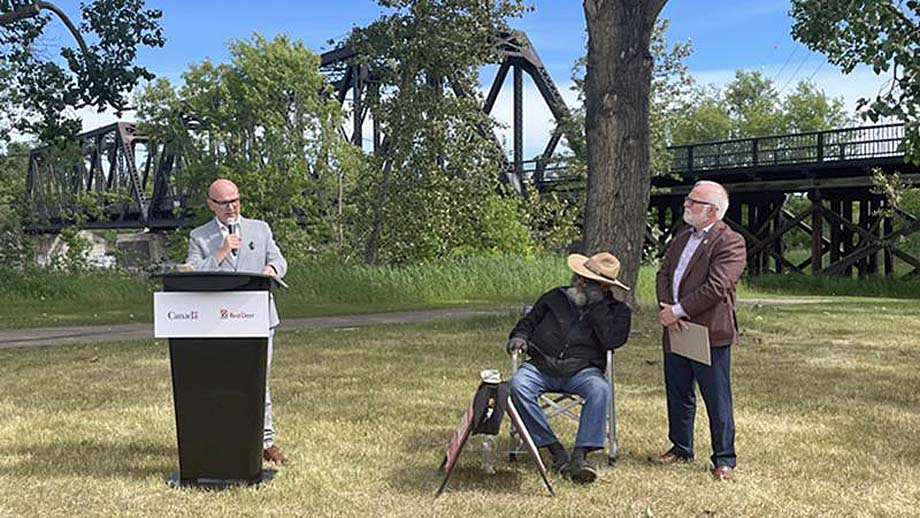

Red Deer Alberta - The Canadian Pacific Railway (CPR) pedestrian bridge will be receiving
significant upgrades to preserve and extend the life of the structure as part of a federally funded, province-wide,
infrastructure upgrade initiative.
On 26 Jun 2024 Randy Boissonnault, minister of employment, workforce development, and official languages, joined Mayor
Ken Johnston and others from city council and administration at the bridge to announce $11.1 million in funding from
the federal government.
The City of Red Deer will be contributing $8.6 million to the project.
"It's a lifeline for our community; it's an artery that connects our downtown to Riverside Meadows, providing
essential access to services and support. Imagine a Red Deer where every resident, regardless of their circumstances,
can navigate our city safely and with ease, that is the vision we're working towards with this project," said
Johnston.
The bridge was first built as a CPR crossing in 1908 and used until 1990, when the rail line was relocated. It was
then set to be demolished until citizens intervened and advocated to have it repurposed as an active transportation
structure.
In 1991, city council designated the structure as a Municipal Historic Resource.
Parks and Public Works Manager Greg Sikora said that from an engineering standpoint, the bridge deck was on track to
reach structural failure in the next five years.
Structural limitations have been in place on the deck for about three years, requiring events like the Long Table
Dinner, which was typically held on the bridge, to relocate.
"We were on a really tight timeframe to get this, because if you talk about running an investment to the end of
its life cycle, we're at the end of its life cycle," he said.
The bridge has three main components, the supporting piers, the deck, and the superstructure.
Sikora said that consultation with engineers and construction professionals conveyed that the most cost-effective
approach to repairs would be to build the new piers adjacent to the existing structure, add a new deck, and then
transfer the superstructure over.
This will cause the bridge to shift about 15 metres downstream.
"The bridge will be rotated slightly and translated a little downstream, so it's going to be taking a little bit
of a different alignment, but it will be true to its core values," Sikora explained.
Portions of the superstructure will be replaced to maintain integrity and the wooden deck with a concrete deck for
durability and performance.
The goal is for the structure to last another 100 years.
As part of the rehabilitation project, the City intends to install an entertainment plaza at the north end of the
bridge with seating and landscape features for residents to enjoy.
This project is still in the design phase.
The bridge rehabilitation is in the tender phase, meaning the City is determining who will take the project
on.
Officials intend to finalize this phase by Q4 this year and are aiming to have the project complete by Q1 of
2026.
The funding announcement is one component of a larger partnership with more than 50 municipalities across the
province.
The Government of Canada is contributing to 48 active and rural public transportation projects with a combined
investment of $60 million.
Municipalities are contributing $24,892,275 to the various projects, and the federal government is contributing
$36,301,698.
The federal investment is supported through the Active Transportation Fund, the Rural Transit Solutions Fund, and the
Public Transit Infrastructure Stream of the Investing in Canada Infrastructure Program.
"Active transportation is defined very broadly and we're a government that believes municipalities should decide
what active transportation looks like for them. In the case of Red Deer, city council was very clear that this is such
a major corridor, getting across the bridge, and such an important community renewal initiative that it just made sense
for us," Boissonnault said.
Boissonnault added that considering the context of Bill 18, now the Provincial Priorities Act, future funding for
projects like this may be difficult for municipalities to secure.
"Bill 18 would make a day like today impossible. The federal money would go to the province and the province
would decide if this project would get funded or not," he said.
Ashley Lavallee-Koenig.
(likely no image with original article)
(usually because it's been seen before)
provisions in Section 29 of the
Canadian Copyright Modernization Act.
